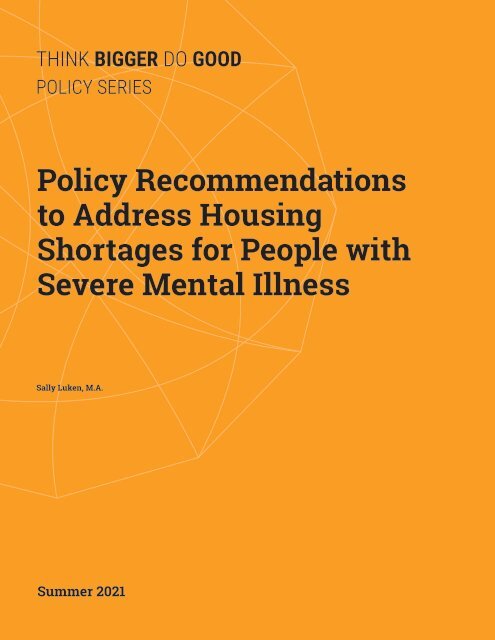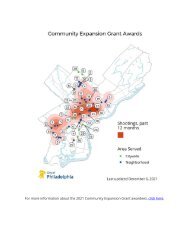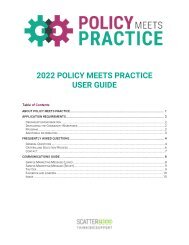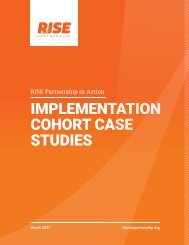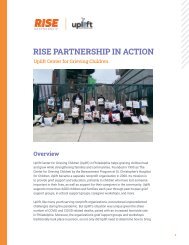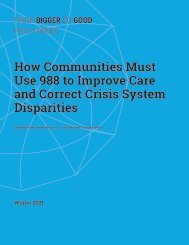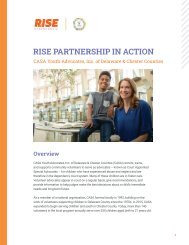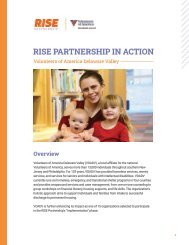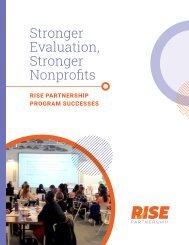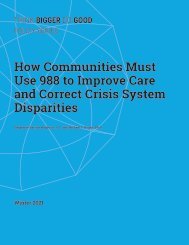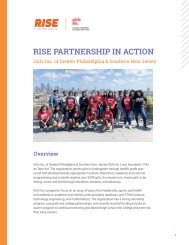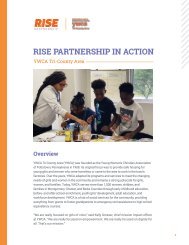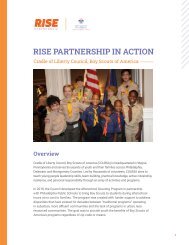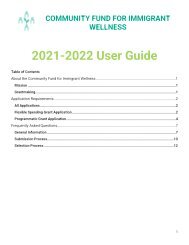Policy Recommendations to Address Housing Shortages for People with Severe Mental Illness
You also want an ePaper? Increase the reach of your titles
YUMPU automatically turns print PDFs into web optimized ePapers that Google loves.
THINK BIGGER DO GOOD<br />
POLICY SERIES<br />
<strong>Policy</strong> <strong>Recommendations</strong><br />
<strong>to</strong> <strong>Address</strong> <strong>Housing</strong><br />
<strong>Shortages</strong> <strong>for</strong> <strong>People</strong> <strong>with</strong><br />
<strong>Severe</strong> <strong>Mental</strong> <strong>Illness</strong><br />
Sally Luken, M.A.<br />
Summer 2021<br />
<strong>Policy</strong> <strong>Recommendations</strong> <strong>to</strong> <strong>Address</strong> <strong>Housing</strong> <strong>Shortages</strong> <strong>for</strong> <strong>People</strong> <strong>with</strong> <strong>Severe</strong> <strong>Mental</strong> <strong>Illness</strong> 1
Behavioral Health and the Individual Health Insurance Market
Dear Reader,<br />
Now is the time <strong>to</strong> solve the growing behavioral health needs in our country by advancing public<br />
policies that trans<strong>for</strong>m the delivery of mental health and substance use disorder services and address<br />
outdated funding mechanisms.<br />
This paper is part of Think Bigger Do Good, a series of papers launched in 2017 through the support and<br />
leadership of the Thomas Scattergood Behavioral Health Foundation and Peg’s Foundation. While the<br />
paper <strong>to</strong>pics continue <strong>to</strong> evolve, our goal <strong>to</strong> develop a policy agenda <strong>to</strong> improve health outcomes <strong>for</strong> all<br />
remains constant.<br />
In partnership <strong>with</strong> national experts in behavioral health, including our edi<strong>to</strong>rs, Howard Goldman<br />
and Constance Gartner, we identified seven critical <strong>to</strong>pics <strong>for</strong> this third series of papers. Each paper<br />
identifies the problem and provides clear, actionable solutions.<br />
We hope you join us in advocating <strong>for</strong> stronger behavioral health policies by sharing this paper <strong>with</strong><br />
your programmatic partners, local, state, and federal decision makers, advocacy organizations, and<br />
voters. To learn more about Think Bigger Do Good and <strong>to</strong> access the other papers in the series, visit<br />
www.thinkbiggerdogood.org.<br />
Sincerely,<br />
Joseph Pyle, M.A.<br />
President<br />
Scattergood Foundation<br />
Founding Partner of Series<br />
Rick Kellar, M.B.A.<br />
President<br />
Peg’s Foundation<br />
Founding Partner of Series<br />
Jane Mogavero, Esq.<br />
Executive Direc<strong>to</strong>r<br />
Patrick P. Lee Foundation<br />
Tracy A. Sawicki<br />
Executive Direc<strong>to</strong>r<br />
Peter & Elizabeth Tower Foundation<br />
<strong>Policy</strong> <strong>Recommendations</strong> <strong>to</strong> <strong>Address</strong> <strong>Housing</strong> <strong>Shortages</strong> <strong>for</strong> <strong>People</strong> <strong>with</strong> <strong>Severe</strong> <strong>Mental</strong> <strong>Illness</strong> 3
We would like <strong>to</strong> acknowledge the following individuals <strong>for</strong> their participation in<br />
the meeting that led <strong>to</strong> the conceptualization of the paper series.<br />
Colleen L. Barry, Ph.D., M.P.P.<br />
John Hopkins Bloomberg School of<br />
Public Health<br />
Cynthia Baum-Baicker, Ph.D.<br />
The Scattergood Foundation<br />
Anita Burgos, Ph.D.<br />
Bipartisan <strong>Policy</strong> Center<br />
Thom Craig, M.P.A.<br />
Peg’s Foundation<br />
Rebecca David, M.P.H.<br />
National Council <strong>for</strong> Behavioral Health<br />
Kelly Davis<br />
<strong>Mental</strong> Health America<br />
Lisa Dixon, M.D., M.P.H.<br />
Columbia University, NY State Psychiatric<br />
Institute, and Psychiatric Services<br />
Sara Dugan, Pharm.D., B.C.P.P., B.C.P.S.<br />
Northeast Ohio Medical University<br />
Peter Earley<br />
Author & Journalist<br />
Alyson Ferguson, M.P.H.<br />
The Scattergood Foundation<br />
Richard Frank, Ph.D.<br />
Harvard Medical School<br />
Rachel Garfield, Ph.D., M.H.S.<br />
The Henry J. Kaiser Family Foundation<br />
Mary Giliberti, J.D.<br />
<strong>Mental</strong> Health America<br />
Aaron Glickman, B.A.<br />
Perelman School of Medicine,<br />
University of Pennsylvania<br />
Sherry Glied, Ph.D.<br />
NYU Wagner School of Public Service<br />
Howard Goldman, M.D., Ph.D.<br />
University of Maryland School<br />
of Medicine<br />
Pamela Greenberg, M.P.P.<br />
Association <strong>for</strong> Behavioral Health<br />
and Wellness<br />
Kimberly Hoagwood, Ph.D.<br />
New York University School of Medicine<br />
Michael F. Hogan, Ph.D.<br />
Hogan Health Solutions<br />
Chuck Ingoglia, M.S.W.<br />
National Council <strong>for</strong> Behavioral Health<br />
Rick Kellar, M.B.A.<br />
Peg’s Foundation<br />
Kelly Kelleher, M.D., M.P.H.<br />
The Research Institute at Nationwide<br />
Children’s Hospital<br />
Jennifer Mathis, J.D.<br />
Bazelon Center <strong>for</strong> <strong>Mental</strong> Health Law<br />
Donald Matteson, M.A.<br />
Peter & Elizabeth Tower Foundation<br />
Brian McGregor, Ph.D.<br />
Satcher Health Leadership Institute,<br />
Morehouse College<br />
Erik Messamore, M.D.<br />
Northeast Ohio Medical University<br />
Ben Miller, PsyD<br />
Well Being Trust<br />
Jane Mogavero, Esq.<br />
Patrick P. Lee Foundation<br />
Mark R. Munetz, M.D.<br />
Northeast Ohio Medical University<br />
Sandra Newman, Ph.D.<br />
John Hopkins Bloomberg School of<br />
Public Health<br />
Joseph Pyle, M.A.<br />
The Scattergood Foundation<br />
Barbara Ricci<br />
Center <strong>for</strong> High Impact Philanthropy<br />
Cheryl Roberts, Esq.<br />
Greenberger Center<br />
Vic<strong>to</strong>ria Romanda<br />
Peg’s Foundation<br />
Tracy A. Sawicki<br />
Peter & Elizabeth Tower Foundation<br />
Lloyd Sederer, M.D.<br />
NYS Office of <strong>Mental</strong> Health/Mailman<br />
School of Public Health<br />
Dominic Sisti, Ph.D.<br />
Scattergood Program <strong>for</strong> Applied Ethics<br />
in Behavioral Health Care & Perelman<br />
School of Medicine at the University<br />
of Pennsylvania<br />
Andrew Sperling, J.D.<br />
NAMI<br />
Kate Williams, J.D.<br />
The Scattergood Foundation<br />
Glenda L. Wrenn, M.D., M.S.H.P.<br />
180 Health Partners<br />
<strong>Policy</strong> <strong>Recommendations</strong> <strong>to</strong> <strong>Address</strong> <strong>Housing</strong> <strong>Shortages</strong> <strong>for</strong> <strong>People</strong> <strong>with</strong> <strong>Severe</strong> <strong>Mental</strong> <strong>Illness</strong> 4
Titles in the Paper Series<br />
Edi<strong>to</strong>rs Howard Goldman, M.D., Ph.D., and Constance Gartner, M.S.W.<br />
America’s Opioid Epidemic<br />
Lloyd I. Sederer, M.D.<br />
Behavioral Health and the Individual Health Insurance Market: Preserving Key Elements of Re<strong>for</strong>m<br />
Richard G. Frank, Ph.D., and Sherry A. Glied, Ph.D., M.A.<br />
Bringing Treatment Parity <strong>to</strong> Jail Inmates <strong>with</strong> Schizophrenia<br />
Mark R. Munetz, M.D., Erik Messamore, M.D., Ph.D., and Sara E. Dugan, Pharm.D., B.C.P.P., B.C.P.S.<br />
Coordinated Specialty Care <strong>for</strong> First-Episode Psychosis: An Example of Financing <strong>for</strong> Specialty Programs<br />
Lisa B. Dixon, M.D., M.P.H.<br />
COVID-19, Structural Racism, and <strong>Mental</strong> Health Inequities: <strong>Policy</strong> Implications <strong>for</strong> an Emerging Syndemic<br />
Ruth S. Shim, M.D., M.P.H., and Steven M. Starks, M.D.<br />
Employing <strong>People</strong> <strong>with</strong> <strong>Mental</strong> <strong>Illness</strong> in the 21st Century: Labor Market Changes and <strong>Policy</strong> Challenges<br />
Richard G. Frank, Ph.D., and Sherry A. Glied, Ph.D., M.A.<br />
Fentanyl and the Evolving Opioid Epidemic: What Strategies Should <strong>Policy</strong>makers Consider?<br />
Colleen L. Barry, Ph.D., M.P.P.<br />
<strong>Housing</strong> Is <strong>Mental</strong> Health Care: A Call <strong>for</strong> Medicaid Demonstration Waivers Covering <strong>Housing</strong><br />
Jennifer Mathis, J.D.<br />
Improving Outcomes <strong>for</strong> <strong>People</strong> <strong>with</strong> Serious <strong>Mental</strong> <strong>Illness</strong> and Co-Occurring Substance Use<br />
Disorders in Contact <strong>with</strong> the Criminal Justice System<br />
Glenda L. Wrenn, M.D., M.S.H.P., Brian McGregor, Ph.D., and Mark R. Munetz, M.D.<br />
In<strong>for</strong>med Consent: A <strong>Policy</strong> Prescription <strong>for</strong> Communicating Benefit and Risk in State Medical Marijuana Program<br />
Erik Messamore, M.D., Ph.D., and Sara E. Dugan, Pharm.D., B.C.P.P., B.C.P.S.<br />
Integrating <strong>Mental</strong> Health and Addiction Treatment in General Medical Care: The Role of <strong>Policy</strong><br />
Emma B. McGinty, Ph.D., M.S., and Gail L. Daumit, M.D., M.H.S.<br />
Medicaid’s Institutions <strong>for</strong> <strong>Mental</strong> Diseases (IMD) Exclusion Rule: A <strong>Policy</strong> Debate<br />
Jennifer Mathis, J.D., Dominic A. Sisti, Ph.D., and Aaron Glickman, B.A.<br />
Meeting the Needs of Justice-Involved <strong>People</strong> <strong>with</strong> Serious <strong>Mental</strong> <strong>Illness</strong> <strong>with</strong>in Community<br />
Behavioral Health Systems<br />
Natalie Bonfine, Ph.D., Amy Blank Wilson, Ph.D., L.S.W., and Mark R. Munetz, M.D.<br />
New Opportunities <strong>to</strong> Improve <strong>Mental</strong> Health Crisis Systems<br />
Michael F. Hogan, Ph.D., and Mathew L. Goldman, M.D., M.S.<br />
<strong>Policy</strong> <strong>Recommendations</strong> <strong>to</strong> <strong>Address</strong> <strong>Housing</strong> <strong>Shortages</strong> <strong>for</strong> <strong>People</strong> <strong>with</strong> <strong>Severe</strong> <strong>Mental</strong> <strong>Illness</strong> 5
Redesigning Federal Health Insurance Policies <strong>to</strong> Promote Children’s <strong>Mental</strong> Health<br />
Kimberly Hoagwood, Ph.D., Kelly Kelleher, M.D., M.P.H., and Michael F. Hogan, Ph.D.<br />
<strong>Policy</strong> and Practice Innovations <strong>to</strong> Improve Prescribing of Psychoactive Medications <strong>for</strong> Children<br />
Kelly J. Kelleher, M.D., M.P.H., David Rubin, M.D., M.S.C.E., and Kimberly Hoagwood, Ph.D.<br />
Preventing Suicide Through Better Firearm Safety <strong>Policy</strong> in the United States<br />
Jeffrey W. Swanson, Ph.D.<br />
Systemic, Racial Justice–In<strong>for</strong>med Solutions <strong>to</strong> Shift “Care” From the Criminal Legal System <strong>to</strong><br />
the <strong>Mental</strong> Health Care System<br />
Sarah Y. Vinson, M.D., and Andrea L. Dennis, J.D.<br />
Suicide Is a Significant Health Problem<br />
Michael F. Hogan, Ph.D.<br />
The Current Medicaid <strong>Policy</strong> Debate and Implications <strong>for</strong> Behavioral Healthcare in the United States<br />
Rachel Garfield, Ph.D., M.H.S., and Julia Zur, Ph.D.<br />
Youth Suicide Is Increasing: Modest Actions Taken Now Can Save Lives<br />
Michael F. Hogan, Ph.D.<br />
Find the papers online at www.thinkbiggerdogood.org<br />
We are grateful <strong>for</strong> the partnership that allows this paper and others <strong>to</strong> appear<br />
in Psychiatric Services, a peer-reviewed monthly journal of the American Psychiatric<br />
Association. Content can be viewed at ps.psychiatryonline.org.<br />
<strong>Policy</strong> <strong>Recommendations</strong> <strong>to</strong> <strong>Address</strong> <strong>Housing</strong> <strong>Shortages</strong> <strong>for</strong> <strong>People</strong> <strong>with</strong> <strong>Severe</strong> <strong>Mental</strong> <strong>Illness</strong> 6
<strong>Policy</strong> <strong>Recommendations</strong><br />
<strong>to</strong> <strong>Address</strong> <strong>Housing</strong><br />
<strong>Shortages</strong> <strong>for</strong> <strong>People</strong> <strong>with</strong><br />
<strong>Severe</strong> <strong>Mental</strong> <strong>Illness</strong><br />
Sally Luken, M.A.<br />
Founder and President<br />
Luken Solutions<br />
sally.luken@lukensolutions.com<br />
<strong>Policy</strong> <strong>Recommendations</strong> <strong>to</strong> <strong>Address</strong> <strong>Housing</strong> <strong>Shortages</strong> <strong>for</strong> <strong>People</strong> <strong>with</strong> <strong>Severe</strong> <strong>Mental</strong> <strong>Illness</strong> 7
U.S. households <strong>with</strong> very low<br />
incomes are disadvantaged in finding<br />
suitable and af<strong>for</strong>dable housing—an<br />
important social determinant of health.<br />
Add <strong>to</strong> poverty the often-disabling<br />
health condition of mental illness, and<br />
these households fall further behind<br />
in the line of households waiting <strong>for</strong><br />
housing opportunities (1).<br />
<strong>Policy</strong> <strong>Recommendations</strong> <strong>to</strong> <strong>Address</strong> <strong>Housing</strong> <strong>Shortages</strong> <strong>for</strong> <strong>People</strong> <strong>with</strong> <strong>Severe</strong> <strong>Mental</strong> <strong>Illness</strong> 8
1<br />
Critical <strong>Housing</strong><br />
Shortage Continues <strong>for</strong><br />
Persons <strong>with</strong> <strong>Severe</strong><br />
<strong>Mental</strong> <strong>Illness</strong><br />
Adults <strong>with</strong> mental health issues whose sole source of income is Supplemental<br />
Security Income—approximately $783 per month—are unable <strong>to</strong> pay monthly<br />
rent, which averages $1,022 per month, be<strong>for</strong>e accounting <strong>for</strong> other costs of basic<br />
living (2). Our system of financial support <strong>for</strong> our most disabled citizens—those<br />
<strong>with</strong> serious and persistent mental illness—assumes that the individual has other<br />
methods of support. This limited income source, <strong>with</strong>out guarantees of other<br />
support, especially housing, cruelly predestines individuals <strong>with</strong> mental illness <strong>to</strong><br />
a possible life of housing instability, including homelessness and cycling in and<br />
out of institutions.<br />
In 2009, Newman and Goldman (3) cited evidence that individuals experiencing<br />
severe and persistent mental illness could live in independent housing and<br />
noted that social service supports should be available <strong>for</strong> those who need them.<br />
Although these authors concluded that the evidence base on effectiveness<br />
of various approaches <strong>to</strong> housing was slim, their conclusions nevertheless<br />
encourage policies promoting supportive housing. They also noted that access<br />
<strong>to</strong> housing was limited and that would-be tenants <strong>with</strong> mental illness reported<br />
discrimina<strong>to</strong>ry practices. Newman and Goldman called <strong>for</strong> expansion of<br />
opportunities and resources and <strong>for</strong> more research.<br />
<strong>Policy</strong> <strong>Recommendations</strong> <strong>to</strong> <strong>Address</strong> <strong>Housing</strong> <strong>Shortages</strong> <strong>for</strong> <strong>People</strong> <strong>with</strong> <strong>Severe</strong> <strong>Mental</strong> <strong>Illness</strong> 9
There are no set-asides or prioritization systems in<br />
federal housing programs <strong>for</strong> people <strong>with</strong> mental<br />
illness—the missing component. The lack of a<br />
coordinated directive from federal policy makers<br />
and a misapplication of federal nondiscrimination<br />
laws, such as Section 504 of the Americans<br />
With Disabilities Act (ADA) and the Olmstead<br />
settlements, perpetuate housing limitations <strong>for</strong><br />
people <strong>with</strong> serious mental illness.<br />
In 2020, Leopold (4) updated the research base and concluded that even in the<br />
absence of strong research answers <strong>to</strong> questions about comparative effectiveness<br />
of specific policies, experts have proposed a number of practical policy solutions.<br />
Leopold called <strong>for</strong> an expansion of funding in the federal government’s 811<br />
program, and Mathis (1) proposed expanding options in Medicaid <strong>for</strong> housing.<br />
Expansion of resources, although needed, does not provide the missing piece in<br />
federal policy <strong>to</strong> address the problem. There are no set-asides or prioritization<br />
systems in federal housing programs <strong>for</strong> people <strong>with</strong> mental illness—the missing<br />
component. The lack of a coordinated directive from federal policy makers<br />
and a misapplication of federal nondiscrimination laws, such as Section 504<br />
of the Americans With Disabilities Act (ADA) and the Olmstead settlements,<br />
perpetuate housing limitations <strong>for</strong> people <strong>with</strong> serious mental illness. This article<br />
analyzes the problem and offers policy proposals <strong>to</strong> increase federal funds while<br />
prioritizing this severely underserved population.<br />
<strong>Policy</strong> <strong>Recommendations</strong> <strong>to</strong> <strong>Address</strong> <strong>Housing</strong> <strong>Shortages</strong> <strong>for</strong> <strong>People</strong> <strong>with</strong> <strong>Severe</strong> <strong>Mental</strong> <strong>Illness</strong> 10
2<br />
The Need <strong>for</strong><br />
Additional Units<br />
per the Data<br />
Approximately 116,000 people <strong>with</strong> mental illness are homeless in the United<br />
States (5), and, although estimates vary, as many as 843,000 people <strong>with</strong> mental<br />
illness are incarcerated (6, 7). These figures do not account <strong>for</strong> the thousands<br />
couch surfing, those living <strong>with</strong> aging parents who are unable <strong>to</strong> cope <strong>with</strong> the<br />
episodic nature of the illness, or those who remain stuck in other institutional<br />
settings.<br />
The United States lacks a national database or<br />
federally coordinated data collection system <strong>to</strong><br />
determine the number and type of housing units<br />
needed <strong>to</strong> house the nearly one million individuals<br />
<strong>with</strong> mental illness estimated <strong>to</strong> be homeless,<br />
incarcerated, or poorly housed (5–7).<br />
The number of housing units needed <strong>to</strong> address this population is unknown. The<br />
United States lacks a national database or federally coordinated data collection<br />
system <strong>to</strong> determine the number and type of housing units needed <strong>to</strong> house the<br />
nearly one million individuals <strong>with</strong> mental illness estimated <strong>to</strong> be homeless,<br />
incarcerated, or poorly housed (5–7). No national database exists, because a<br />
federal policy <strong>to</strong> eradicate the problem has never developed.<br />
<strong>Policy</strong> <strong>Recommendations</strong> <strong>to</strong> <strong>Address</strong> <strong>Housing</strong> <strong>Shortages</strong> <strong>for</strong> <strong>People</strong> <strong>with</strong> <strong>Severe</strong> <strong>Mental</strong> <strong>Illness</strong> 11
Many states and local communities have developed<br />
their own housing goals, but often these have not<br />
addressed the need. In more recent years, goals have<br />
been embedded in the federal policy <strong>to</strong> end homelessness<br />
or <strong>to</strong> meet legal settlements between the U.S. Department<br />
of Justice (DOJ) and local governments <strong>to</strong> uphold the<br />
Supreme Court’s 1999 Olmstead decision, which found<br />
that the unjustified segregation of people <strong>with</strong> disabilities<br />
is a <strong>for</strong>m of unlawful discrimination under the ADA.<br />
These ef<strong>for</strong>ts have worthy goals, but they do not address<br />
persons <strong>with</strong> mental health illness who do not meet the<br />
federal homeless definitions or who are overlooked in<br />
Olmstead settlements.<br />
Laws developed <strong>to</strong> protect the rights of disabled persons<br />
have had unintended consequences in housing <strong>for</strong><br />
people <strong>with</strong> mental illness. Section 504 of the ADA does<br />
not allow a qualified individual <strong>to</strong> be denied access <strong>to</strong> or<br />
discriminated against in federally funded programs or<br />
services on the basis of the person’s disabilities. This has<br />
been interpreted <strong>to</strong> mean that under no circumstance<br />
should one disability class have preference over<br />
another in housing access. However, Section 504 allows<br />
distinctions based on disabilities, if the distinction<br />
provides “equal access <strong>to</strong> housing” (8). U.S. Department<br />
of <strong>Housing</strong> and Urban Development (HUD) officials have<br />
stated that if Congress provides an authorizing statute or<br />
if the Administration provides an executive order, federal<br />
housing programs can limit occupancy <strong>to</strong> people <strong>with</strong><br />
one particular disability (9).<br />
Olmstead settlements have caused some local<br />
governments <strong>to</strong> believe that prioritizing federal housing<br />
resources <strong>for</strong> any particular disability group is a violation<br />
of law. Yet, the DOJ, which litigates these cases, found<br />
that the plaintiffs in M.G. v. Cuomo had standing <strong>to</strong> make<br />
a claim that New York State did not provide adequate<br />
community-based mental health housing and services<br />
<strong>for</strong> people <strong>with</strong> mental illness leaving state prison. The<br />
DOJ stated that <strong>with</strong>out mental health housing, this<br />
disability group was being segregated upon release (in<br />
homeless shelters) or was at risk of reinstitutionalization,<br />
both violations of federal law (10).<br />
The lack of a directive from the federal government, <strong>with</strong><br />
the patchwork of funding, makes solving the shortage<br />
of housing <strong>for</strong> persons <strong>with</strong> mental illness a challenge,<br />
whether in New York City or Des Moines. A federal and<br />
state compact <strong>with</strong> robust financial supports and specific<br />
goals prioritizing this population is needed.<br />
A federal and state compact <strong>with</strong><br />
robust financial supports and specific<br />
goals prioritizing this population<br />
is needed.<br />
<strong>Policy</strong> <strong>Recommendations</strong> <strong>to</strong> <strong>Address</strong> <strong>Housing</strong> <strong>Shortages</strong> <strong>for</strong> <strong>People</strong> <strong>with</strong> <strong>Severe</strong> <strong>Mental</strong> <strong>Illness</strong> 12
3<br />
Necessary<br />
Components of<br />
Af<strong>for</strong>dable <strong>Housing</strong><br />
Development and<br />
Operations<br />
Development of new housing units <strong>for</strong> persons <strong>with</strong> disabilities requires what<br />
housing experts refer <strong>to</strong> as the three legs of the s<strong>to</strong>ol: capital, operations, and<br />
services.<br />
Capital Sources and Uses<br />
Capital is used <strong>to</strong> acquire land or buildings, construct new units, or rehabilitate<br />
existing units. There is a myriad of costs in these tasks, including architectural;<br />
engineering; legal; environmental; inves<strong>to</strong>r requirements; federal, state, and local<br />
regula<strong>to</strong>ry requirements; licensing; fees; insurance; utilities; property taxes; and<br />
debt services.<br />
The Low-Income <strong>Housing</strong> Tax Credit (LIHTC) program is the largest source of<br />
capital funding in the United States <strong>for</strong> housing that is built <strong>for</strong> low- or moderateincome<br />
households. A Treasury Department program, created by the Tax Re<strong>for</strong>m<br />
Act of 1986, the LIHTC program gives state and local agencies the equivalent of<br />
approximately $8 billion in annual budget authority <strong>to</strong> issue tax credits <strong>for</strong> the<br />
acquisition, rehabilitation, or new construction of rental housing targeted <strong>to</strong><br />
lower-income households (11).<br />
<strong>Policy</strong> <strong>Recommendations</strong> <strong>to</strong> <strong>Address</strong> <strong>Housing</strong> <strong>Shortages</strong> <strong>for</strong> <strong>People</strong> <strong>with</strong> <strong>Severe</strong> <strong>Mental</strong> <strong>Illness</strong> 13
The median cost <strong>to</strong> create one, one-bedroom apartment<br />
using LIHTC is nearly $186,000 in 2020 dollars (12). That per<br />
unit cost is heavily influenced by location and density of<br />
a project. Building an apartment building in Los Angeles<br />
costs more than in Ocala, Florida; 25 units is more costly<br />
per unit than 250. Other fac<strong>to</strong>rs contribute <strong>to</strong> capital cost<br />
per unit, such as a lack of raw materials, newly imposed<br />
import tariffs on items such as appliances, or a legal battle<br />
against local citizens who object <strong>to</strong> a project arguing<br />
“Not In My Back Yard” (NIMBY), a common occurrence in<br />
af<strong>for</strong>dable housing development, arising from neighbors<br />
or businesses objecting <strong>to</strong> a proposed project in what<br />
they consider their neighborhood and based on bias,<br />
misunderstanding, or fear.<br />
In all jurisdictions across the country,<br />
there is no one source of capital <strong>for</strong><br />
housing development, which requires<br />
a developer <strong>to</strong> braid as many as eight<br />
<strong>to</strong> 12 funding sources <strong>to</strong> cover all the<br />
costs associated <strong>with</strong> any project.<br />
Competition <strong>for</strong> capital resources is high, resulting in<br />
additional costs if applications are repeated multiple<br />
times be<strong>for</strong>e award. The good news is that all of this<br />
complexity has spawned an industry of sophisticated<br />
af<strong>for</strong>dable housing developers. The bad news is that most<br />
do not make a habit of developing housing <strong>for</strong> people <strong>with</strong><br />
mental illness.<br />
Operation Sources and Uses<br />
“Operations” refers <strong>to</strong> the expense of keeping the<br />
apartments functional and taking care of the asset over<br />
time. Landlords also like <strong>to</strong> make a profit, including<br />
nonprofit landlords. Rents are the primary source of<br />
revenues <strong>for</strong> operations.<br />
Mom-and-pop landlords can set their rents at any level<br />
that their local markets will bear. <strong>Housing</strong> developments<br />
that use public funds normally must use fair market rents<br />
(FMRs) <strong>to</strong> set their rent levels. FMRs are established by<br />
HUD. Often additional compliance requirements translate<br />
in<strong>to</strong> the need <strong>for</strong> rents that are high enough <strong>for</strong> a landlord<br />
<strong>to</strong> cover costs. What this means <strong>for</strong> low-income people<br />
<strong>with</strong> mental illness is that rental subsidies are critical <strong>to</strong><br />
their housing success.<br />
Un<strong>for</strong>tunately, an LIHTC award never finances 100% of<br />
a project. In all jurisdictions across the country, there<br />
is no one source of capital <strong>for</strong> housing development,<br />
which requires a developer <strong>to</strong> braid as many as eight <strong>to</strong><br />
12 funding sources <strong>to</strong> cover all the costs associated <strong>with</strong><br />
any project. The time involved in cobbling <strong>to</strong>gether this<br />
patchwork can also be onerous. New developments can<br />
take 2 <strong>to</strong> 6 years. Time is money.<br />
<strong>Policy</strong> <strong>Recommendations</strong> <strong>to</strong> <strong>Address</strong> <strong>Housing</strong> <strong>Shortages</strong> <strong>for</strong> <strong>People</strong> <strong>with</strong> <strong>Severe</strong> <strong>Mental</strong> <strong>Illness</strong> 14
Rental subsidies come in two types:<br />
project-based rental assistance<br />
(PBRA) and tenant-based rental<br />
assistance (TBRA).<br />
Rental subsidies come in two types: project-based rental<br />
assistance (PBRA) and tenant-based rental assistance<br />
(TBRA). PBRA subsidies are attached <strong>to</strong> a particular unit<br />
<strong>with</strong>in a specific building. The subsidy stays <strong>with</strong> the<br />
unit or “project” no matter who the eligible tenant is at<br />
any given time. These are helpful <strong>to</strong> projects that serve<br />
extremely low-income tenants and that may specialize in<br />
meeting goals, such as <strong>to</strong> end homelessness. A consistent<br />
source of rents, such as PBRA subsidies, can financially<br />
stabilize a project. TBRA subsidies do as they sound—the<br />
eligible household receives the rent subsidy and uses it<br />
in any af<strong>for</strong>dable apartment or house where a landlord is<br />
willing <strong>to</strong> accept it. These are helpful <strong>to</strong> the household by<br />
providing choice and portability, if there is an adequate<br />
supply of willing landlords whose units have passed<br />
muster <strong>with</strong> HUD’s housing quality standards.<br />
HUD provides the bulk of rental subsidies <strong>for</strong> eligible<br />
households through mainstream housing choice<br />
vouchers (HCVs)—<strong>for</strong>merly referred <strong>to</strong> as Section 8<br />
vouchers. Other HUD rental subsidies are embedded in<br />
rental units owned by local public housing authorities,<br />
in homeless assistance programs, in the HUD 811<br />
program (described below), and in special, short-term<br />
interventions, such as the nonelderly disabled category of<br />
HCVs. Some local and state governments provide rental<br />
subsidies <strong>to</strong> address a local issue, although many are<br />
intended <strong>for</strong> temporary assistance and expire after 3, 6, or<br />
12 months. Nowhere are rental subsidies an entitlement.<br />
Waitlists are long, and there are challenges <strong>for</strong> people<br />
<strong>with</strong> criminal his<strong>to</strong>ries or ongoing issues <strong>with</strong> recovery <strong>to</strong><br />
obtain a place in line.<br />
<strong>Policy</strong> <strong>Recommendations</strong> <strong>to</strong> <strong>Address</strong> <strong>Housing</strong> <strong>Shortages</strong> <strong>for</strong> <strong>People</strong> <strong>with</strong> <strong>Severe</strong> <strong>Mental</strong> <strong>Illness</strong> 15
Services Sources and Uses<br />
When a disabled person signs a lease and lives<br />
independently, often his or her independence is<br />
actually reliant on some level of support. Supports can<br />
vary depending on the individual’s need and desires.<br />
Supports may include help moving in<strong>to</strong> a unit; provision<br />
of household items; help <strong>with</strong> access <strong>to</strong> communitybased<br />
services, health care, and treatment; support<br />
<strong>with</strong> building a community of friends; and help finding<br />
employment. Service supports help a person <strong>with</strong> mental<br />
illness maintain housing, such as by advocating <strong>with</strong><br />
a landlord when a tenant knowingly or unknowingly<br />
violates the lease or assisting the tenant <strong>to</strong> complete the<br />
rental subsidy recertification paperwork.<br />
There<strong>for</strong>e, state and local<br />
governments or local philanthropy<br />
supplement Medicaid, which leads<br />
<strong>to</strong> inconsistencies across states and<br />
locales in the levels of services that a<br />
person <strong>with</strong> mental illness receives <strong>to</strong><br />
live independently.<br />
Medicaid is the primary source of revenue <strong>for</strong> some of<br />
these supports. In some locations, Medicaid does not<br />
cover what are called “tenancy supports,” only the obvious<br />
medically related services. There<strong>for</strong>e, state and local<br />
governments or local philanthropy supplement Medicaid,<br />
which leads <strong>to</strong> inconsistencies across states and locales<br />
in the levels of services that a person <strong>with</strong> mental illness<br />
receives <strong>to</strong> live independently. Services that are offered<br />
and accepted by the tenant on a voluntary basis are also<br />
most effective in sustaining housing (13).<br />
All three legs of the housing s<strong>to</strong>ol—capital, operations<br />
(rent subsidies), and services—are oversubscribed or<br />
underfunded <strong>to</strong> the need. The sophisticated af<strong>for</strong>dable<br />
housing developers have a choice of developing<br />
new units <strong>for</strong> a variety of moderate- or low-income<br />
households. Private landlords in most markets look <strong>for</strong><br />
tenants <strong>with</strong> higher incomes or better tenancy his<strong>to</strong>ries.<br />
It is more complicated when developing <strong>for</strong>, and then<br />
renting <strong>to</strong>, persons <strong>with</strong> episodic health issues. As a<br />
result, nonprofits or local governments have typically<br />
delivered housing <strong>for</strong> this population at insufficient<br />
quantities.<br />
<strong>Policy</strong> <strong>Recommendations</strong> <strong>to</strong> <strong>Address</strong> <strong>Housing</strong> <strong>Shortages</strong> <strong>for</strong> <strong>People</strong> <strong>with</strong> <strong>Severe</strong> <strong>Mental</strong> <strong>Illness</strong> 16
4<br />
The Federal 811<br />
<strong>Housing</strong> Program <strong>for</strong><br />
Persons <strong>with</strong> Disabilities<br />
From 1960 <strong>to</strong> 1990, the federal government invested funds in two legs of the s<strong>to</strong>ol,<br />
capital and operations (as rent subsidies), <strong>for</strong> new housing <strong>for</strong> “handicapped”<br />
people as a subset of an elderly housing program called 202. This was the first<br />
federal attempt at developing housing <strong>for</strong> people <strong>with</strong> disabilities. The need <strong>for</strong><br />
this housing continued <strong>to</strong> be evident, and in 1990, the Crans<strong>to</strong>n-Gonzalez National<br />
Af<strong>for</strong>dable <strong>Housing</strong> Act provided <strong>for</strong> a special program, Supportive <strong>Housing</strong> <strong>for</strong><br />
Persons <strong>with</strong> Disabilities, referred <strong>to</strong> as 811 (“eight-eleven”) (14).<br />
Through 811, nonprofit organizations applied directly <strong>to</strong> HUD <strong>for</strong> capital grants,<br />
accompanied by 5-year commitments <strong>for</strong> rental subsidies as PBRA. <strong>Housing</strong><br />
types <strong>for</strong> development could include group homes, independent living facilities,<br />
multifamily rental units, condominium units, and cooperative housing <strong>with</strong><br />
limitations on size—not more than eight or 16 units depending on the type. The<br />
nonprofit receiving the 811 funds committed <strong>to</strong> providing the third leg of the<br />
s<strong>to</strong>ol—services. The 811 program also awarded stand-alone TBRA subsidies but at<br />
a smaller amount.<br />
This model provided nonprofit groups, many of which were small organizations,<br />
a single source application <strong>for</strong> two of the funds hardest <strong>to</strong> come by <strong>for</strong> af<strong>for</strong>dable<br />
housing. This was a boon <strong>to</strong> local providers wanting <strong>to</strong> house their own clients<br />
and <strong>for</strong> those in areas <strong>with</strong> little or no capital. The commitment <strong>for</strong> 5 years of<br />
rental subsidy <strong>with</strong> the capital allowed clients <strong>to</strong> skip the long waiting lists <strong>for</strong><br />
other rent subsidies.<br />
What did 811 produce? Actual numbers of units created <strong>for</strong> persons <strong>with</strong><br />
disabilities since 1960 are unknown, but HUD estimates that 30,000 units were<br />
created from 1990 through 2010—or 1,500 new units a year (15). That is a paltry and<br />
low national production pipeline. The units had <strong>to</strong> be available <strong>to</strong> any disability<br />
class as long as the person was age 18 <strong>to</strong> 61. As a result, many units did not house<br />
people <strong>with</strong> mental illness, further diluting the impact <strong>for</strong> this population.<br />
<strong>Policy</strong> <strong>Recommendations</strong> <strong>to</strong> <strong>Address</strong> <strong>Housing</strong> <strong>Shortages</strong> <strong>for</strong> <strong>People</strong> <strong>with</strong> <strong>Severe</strong> <strong>Mental</strong> <strong>Illness</strong> 17
5<br />
The Melville Act<br />
2010 Creates a New<br />
811 Program<br />
Little has been published outlining successes of the early 811 model.<br />
Instead, issues arose that made people question its efficacy and cost. A 2019<br />
Congressional Research Services report <strong>to</strong> Congress on federal housing<br />
programs stated that federal officials worried about the cost per unit (14).<br />
According <strong>to</strong> 811 program experts, advocates <strong>for</strong> the disabled community argued<br />
<strong>for</strong> more integration, others wanted <strong>to</strong> attract the sophisticated developers who<br />
used LIHTC, and Congress wanted <strong>to</strong> shift its role in housing production <strong>to</strong> states<br />
(personal communication, Sperling A., National Alliance <strong>for</strong> the <strong>Mental</strong>ly Ill;<br />
Sloane L., Technical Assistance Collaborative, Feb. 2021). The TBRA (tenant-based<br />
subsidy) component of 811 needed regular reauthorizations <strong>to</strong> preserve existing<br />
units. In other words, rent subsidies needed <strong>to</strong> be maintained beyond the initial<br />
funding period so that existing tenants did not lose their housing.<br />
This squeezed the program from producing new units, because annual<br />
Congressional appropriations were limited. In addition, the 2007–2008 housing<br />
market collapse caused all af<strong>for</strong>dable housing industry stakeholders <strong>to</strong> rethink<br />
financing of housing.<br />
With advocates’ assistance, and <strong>with</strong> an eye on leveraging the largest capital<br />
source—that is, LIHTC—811 was amended. The 2010 Frank Melville Supportive<br />
<strong>Housing</strong> Investment Act did not do away <strong>with</strong> the original model, although some<br />
housing providers thought so. In fact, the Melville Act amended 811 <strong>to</strong> provide<br />
an incentive <strong>for</strong> states <strong>to</strong> be more involved and <strong>to</strong> create greater opportunities<br />
<strong>for</strong> a small number of units dedicated <strong>to</strong> people <strong>with</strong> disabilities in large-scale<br />
af<strong>for</strong>dable housing projects.<br />
<strong>Policy</strong> <strong>Recommendations</strong> <strong>to</strong> <strong>Address</strong> <strong>Housing</strong> <strong>Shortages</strong> <strong>for</strong> <strong>People</strong> <strong>with</strong> <strong>Severe</strong> <strong>Mental</strong> <strong>Illness</strong> 18
The 811 program’s competitive grants <strong>to</strong> states source the<br />
three legs of the s<strong>to</strong>ol differently, according <strong>to</strong> a state’s<br />
plan. Capital is entirely from other sources, most notably<br />
from LIHTC. Operations are 811, using project rental<br />
assistance (PRA), <strong>with</strong> important caveats: the services<br />
must be guaranteed from the state, primarily from<br />
Medicaid, and units dedicated <strong>to</strong> people <strong>with</strong> disabilities<br />
are maxed at 25% in a project.<br />
What It Produces and Benefits<br />
Twenty-seven states are contracting <strong>with</strong> HUD <strong>for</strong> 811<br />
PRA. Nearly 5,500 811 PRA units were identified during<br />
the years 2015 <strong>to</strong> 2020 (federal funds did not flow until<br />
2013) (16). The units, integrated in<strong>to</strong> existing af<strong>for</strong>dable<br />
housing projects, are providing an important alternative<br />
<strong>to</strong> other options <strong>for</strong> persons <strong>with</strong> disabilities. In some<br />
states, where an Olmstead settlement exists, 811 PRA is a<br />
positive step <strong>to</strong>ward meeting integration requirements.<br />
Having another federal rent subsidy is an important<br />
incentive <strong>for</strong> a state <strong>to</strong> invest in the other two legs (capital<br />
and services) <strong>to</strong> meet requirements.<br />
What Are the Challenges?<br />
Some believe 811 PRA is producing more units. However,<br />
the rate of “production” is actually slightly less than <strong>with</strong><br />
the <strong>for</strong>mer model. Nationally, 5,500 units in the course<br />
of 5 years is only 1,100 annually. Although 5,500 units<br />
were identified, only 1,901 households are living in the 811<br />
units (16). All new programs take time <strong>to</strong> ramp up, and<br />
in time other “identified units” may be filled. But is this a<br />
success <strong>for</strong> people <strong>with</strong> mental illness? In addition <strong>to</strong> this<br />
low rate of actually housed people, there have not been<br />
consistent annual congressional appropriations <strong>for</strong> 811 <strong>to</strong><br />
significantly expand new housing units.<br />
A finding that needs further<br />
moni<strong>to</strong>ring, according <strong>to</strong> 811 program<br />
evalua<strong>to</strong>rs, is that people <strong>with</strong> mental<br />
illness are ineligible <strong>for</strong> admission<br />
<strong>to</strong> units at higher rates than other<br />
disability groups (17).<br />
Once again, there is evidence that as <strong>with</strong> other subsidies<br />
not earmarked <strong>for</strong> people <strong>with</strong> severe mental illness,<br />
many units are going <strong>to</strong> people <strong>with</strong> other disabilities.<br />
A finding that needs further moni<strong>to</strong>ring, according <strong>to</strong> 811<br />
program evalua<strong>to</strong>rs, is that people <strong>with</strong> mental illness are<br />
ineligible <strong>for</strong> admission <strong>to</strong> units at higher rates than other<br />
disability groups (17). HUD’s 811 PRA success s<strong>to</strong>ry is of a<br />
man in Massachusetts who moved from a nursing home<br />
in<strong>to</strong> an 811 apartment (16). His disability was physical.<br />
The sample client <strong>for</strong> Ohio’s 811 program training modules<br />
is a person <strong>with</strong> a physical disability; and providers who<br />
talk of the success of the 811 PRA are those who work<br />
<strong>with</strong> people <strong>with</strong> development disabilities (personal<br />
experience of the author, who completed Ohio’s 811<br />
PRA program’s online training curriculum, Feb. 2021).<br />
The federal government’s website on the ADA <strong>to</strong>uts<br />
the successes of Olmstead settlements, but the s<strong>to</strong>ries<br />
are primarily about individuals <strong>with</strong> developmental<br />
disabilities (18).<br />
<strong>Policy</strong> <strong>Recommendations</strong> <strong>to</strong> <strong>Address</strong> <strong>Housing</strong> <strong>Shortages</strong> <strong>for</strong> <strong>People</strong> <strong>with</strong> <strong>Severe</strong> <strong>Mental</strong> <strong>Illness</strong> 19
6<br />
A <strong>Housing</strong> <strong>Policy</strong><br />
Proposal That<br />
<strong>Address</strong>es the Need<br />
The 811 program currently is not structured or funded <strong>for</strong> the necessary impact<br />
on people <strong>with</strong> mental illness who need housing. Structurally, Congress would<br />
again need <strong>to</strong> change 811 language <strong>to</strong> accomplish any significant impact.<br />
Language changes should require prioritization of people <strong>with</strong> mental illness or<br />
a set-aside of units <strong>for</strong> this population and additional local mandates <strong>for</strong> awards,<br />
such as collaboration on assessing and housing the most vulnerable or those<br />
<strong>with</strong> mental illness who cycle in and out of public institutions. Documented local<br />
involvement in the process <strong>for</strong> assessment should cross disciplines and systems,<br />
including criminal justice, hospitals, mental health, and housing.<br />
Language changes should require prioritization of<br />
people <strong>with</strong> mental illness or a set-aside of units<br />
<strong>for</strong> this population and additional local mandates<br />
<strong>for</strong> awards, such as collaboration on assessing and<br />
housing the most vulnerable or those <strong>with</strong> mental<br />
illness who cycle in and out of public institutions.<br />
<strong>Policy</strong> <strong>Recommendations</strong> <strong>to</strong> <strong>Address</strong> <strong>Housing</strong> <strong>Shortages</strong> <strong>for</strong> <strong>People</strong> <strong>with</strong> <strong>Severe</strong> <strong>Mental</strong> <strong>Illness</strong> 20
To achieve decent production levels,<br />
funding <strong>with</strong>in 811 <strong>for</strong> the two legs<br />
of the s<strong>to</strong>ol—capital and rental<br />
subsidies—would need <strong>to</strong> be boosted<br />
<strong>to</strong> five <strong>to</strong> ten times recent<br />
appropriations.<br />
Capital should continue <strong>to</strong> be available <strong>for</strong> a variety of<br />
housing types, allowing <strong>for</strong> local decision making based<br />
on current inven<strong>to</strong>ries while retaining the option of<br />
integration <strong>with</strong>in larger housing projects and supporting<br />
consumer choice in housing as much as possible, given<br />
limited resources. HUD should require local or state<br />
assessment of need so that capital and rent subsidy<br />
requests match the local need and tenant choice in the<br />
types of housing available. To achieve decent production<br />
levels, funding <strong>with</strong>in 811 <strong>for</strong> the two legs of the s<strong>to</strong>ol—<br />
capital and rental subsidies—would need <strong>to</strong> be boosted<br />
<strong>to</strong> five <strong>to</strong> ten times recent appropriations. The nearly one<br />
million people <strong>with</strong> mental illness who need housing now<br />
or will need housing on institutional release (5–7) cannot<br />
be assisted by a few thousand new units.<br />
Two federal initiatives, the federal Plan <strong>to</strong> End<br />
Homelessness and the Community Living Project, have<br />
taught us that anything less than a federal directive is a<br />
hobbled response <strong>to</strong> a critical social problem. A federal<br />
policy and commitment <strong>to</strong> develop housing <strong>for</strong> people<br />
<strong>with</strong> mental illness must include federal authorizing<br />
legislation, media and public relations investments,<br />
federal technical assistance on best practices, federal<br />
interagency cooperation, requirements <strong>for</strong> local<br />
collaborative bodies that are charged <strong>with</strong> investing<br />
in and moni<strong>to</strong>ring audacious goals, federal funds that<br />
leverage mainstream and philanthropic funds, data<br />
collection, and research and evaluation. The federal<br />
policy <strong>to</strong> address the housing shortage <strong>for</strong> people <strong>with</strong><br />
mental illness could start <strong>with</strong> 811 but must include far<br />
more than one HUD program.<br />
To meet the third leg of the s<strong>to</strong>ol—service supports—in<br />
a manner that many of these individuals will likely<br />
need, Congress should direct federal agencies <strong>to</strong> review<br />
all existing programs and awards <strong>to</strong> increase service<br />
supports and collaboration <strong>with</strong> HUD’s 811 program.<br />
For example, new 811 grants could be made only where<br />
Medicaid expansion and Medicaid waivers or state plan<br />
amendments are in place <strong>for</strong> tenancy supports, which<br />
would help ensure housing success. Other service support<br />
funding streams could be found in federal departmental<br />
programs <strong>with</strong>in the DOJ and the Substance Abuse and<br />
<strong>Mental</strong> Health Services Administration.<br />
<strong>Policy</strong> <strong>Recommendations</strong> <strong>to</strong> <strong>Address</strong> <strong>Housing</strong> <strong>Shortages</strong> <strong>for</strong> <strong>People</strong> <strong>with</strong> <strong>Severe</strong> <strong>Mental</strong> <strong>Illness</strong> 21
References<br />
1<br />
2<br />
3<br />
4<br />
5<br />
6<br />
7<br />
8<br />
9<br />
10<br />
11<br />
12<br />
Mathis J: <strong>Housing</strong> is mental health care: a call <strong>for</strong> Medicaid demonstration waivers covering housing.<br />
Psychiatr Serv (Epub ahead of print, Dec 18, 2020).<br />
Priced Out in the United States. Bos<strong>to</strong>n, Technical Assistance Collaborative, 2021. Available here<br />
https://www.tacinc.org/resources/priced-out/.<br />
Newman SJ, Goldman HH: <strong>Housing</strong> policy <strong>for</strong> people <strong>with</strong> severe mental illness.<br />
<strong>Policy</strong> Stud J 37:299–324, 2009.<br />
Leopold J: <strong>Housing</strong> <strong>for</strong> <strong>People</strong> <strong>with</strong> Serious <strong>Mental</strong> <strong>Illness</strong>, in The Palgrave Handbook of American <strong>Mental</strong><br />
Health <strong>Policy</strong>. Edited by Goldman HH, Frank RG, Morrissey JP. New York, Palgrave Macmillan, 2020.<br />
HUD 2019 Continuum of Care Homeless Assistance Programs Homeless Populations and Subpopulations.<br />
Washing<strong>to</strong>n, DC, US Department of <strong>Housing</strong> and Urban Development, 2019. Available here<br />
https://files.hudexchange.info/reports/published/CoC_PopSub_NatlTerrDC_2019.pdf.<br />
State Prisons, Local Jails, and Federal Prisons, Incarceration Rates and Counts 1925–2016. Northamp<strong>to</strong>n,<br />
MA, Prison <strong>Policy</strong> Initiative, 2021. Available here https://www.prisonpolicy.org/data/#nat.<br />
<strong>Mental</strong> Health: Policies and Practices Surrounding <strong>Mental</strong> Health. Northamp<strong>to</strong>n, MA, Prison <strong>Policy</strong><br />
Initiative, 2021. Available here https://www.prisonpolicy.org/research/mental_health/.<br />
Goldfarb and Lipman LLP: Between the Lines: A Question and Answer Guide on Legal Issues in Supportive<br />
<strong>Housing</strong> (Cali<strong>for</strong>nia Edition). New York, Corporation <strong>for</strong> Supportive <strong>Housing</strong>, 2010. Available here<br />
https://www.csh.org/wp-content/uploads/2011/12/Tool_BTL_CA1.pdf.<br />
Feasibility Study: HUD Collaboration <strong>with</strong> Substance Abuse and <strong>Mental</strong> Health Services Administration<br />
(SAMHSA) on a HUD-VASH-Type Program. Report prepared in response <strong>to</strong> House Report 116-106<br />
accompanying the Further Consolidated Appropriations Act. Washing<strong>to</strong>n, DC, 116th Congress, House<br />
Appropriations Committee, 2020.<br />
Statement of Interest of the United States of America in MG v Cuomo. New York, United States District<br />
Court, Southern District of New York, 2021. https://www.ada.gov/mg_cuomo_soi.html.<br />
Low-Income <strong>Housing</strong> Tax Credits. San Francisco, National <strong>Housing</strong> Law Project, 2021. Available here<br />
https://www.nhlp.org/resource-center/low-income-housing-tax-credits/.<br />
Variation in Development Costs <strong>for</strong> LIHTC Projects. Washing<strong>to</strong>n, DC, National Council of State <strong>Housing</strong><br />
Agencies, 2018. Available here https://www.ncsha.org/wp-content/uploads/2018/09/Final-LIHTC-Costs-<br />
Analysis_2018_08_31.pdf.<br />
<strong>Policy</strong> <strong>Recommendations</strong> <strong>to</strong> <strong>Address</strong> <strong>Housing</strong> <strong>Shortages</strong> <strong>for</strong> <strong>People</strong> <strong>with</strong> <strong>Severe</strong> <strong>Mental</strong> <strong>Illness</strong> 22
13<br />
14<br />
15<br />
16<br />
17<br />
18<br />
Supportive <strong>Housing</strong> Research FAQs: Do Voluntary Services Work? New York, Corporation <strong>for</strong><br />
Supportive <strong>Housing</strong>, 2011. Available here https://www.csh.org/wp-content/uploads/2011/11/<br />
VoluntaryServicesFAQFINAL.pdf.<br />
Overview of Federal <strong>Housing</strong> Assistance Programs and <strong>Policy</strong>: Updated March 27, 2019. Washing<strong>to</strong>n, DC,<br />
Congressional Research Services, 2019. Available here https://crsreports.congress.gov/product/pdf/RL/<br />
RL34591.<br />
Galante C: The Frank Melville Supportive <strong>Housing</strong> Investment Act: Section 811’s New “Project Rental<br />
Assistance (PRA)” Authority. Washing<strong>to</strong>n, DC, US Department of <strong>Housing</strong> and Urban Development,<br />
Office of Multifamily <strong>Housing</strong> Programs, 2011. Available here https://www.hud.gov/sites/documents/<br />
HUPRAPRESENTATION041411.PDF.<br />
Section 811 Project Rental Assistance Program: Successfully Supporting Independent Living <strong>for</strong> <strong>People</strong><br />
<strong>with</strong> Disabilities. Washing<strong>to</strong>n, DC, US Department of <strong>Housing</strong> and Urban Development, HUD Exchange,<br />
May 2020. Available here https://www.hudexchange.info/resource/6032/section-811-pra-successfullysupporting-independent-living/.<br />
Pinkett R, Jones C, Crumel K, et al: Section 811 Project Rental Assistance Program: Process Evaluation<br />
Report. Cambridge, MA, Abt Associates Inc, Jan 2018. Available here https://www.abtassociates.com/<br />
insights/publications/report/section-811-project-rental-assistance-program-process-evaluation.<br />
Olmstead: Community Integration <strong>for</strong> Everyone. Washing<strong>to</strong>n, DC, US Department of Justice, Civil Rights<br />
Division, ADA.gov, 2021. Available here https://www.ada.gov/olmstead/olmstead_about.htm.<br />
<strong>Policy</strong> <strong>Recommendations</strong> <strong>to</strong> <strong>Address</strong> <strong>Housing</strong> <strong>Shortages</strong> <strong>for</strong> <strong>People</strong> <strong>with</strong> <strong>Severe</strong> <strong>Mental</strong> <strong>Illness</strong> 23
How <strong>to</strong> use this paper <strong>to</strong><br />
“Think Bigger” and “Do Good”<br />
1 Send the paper <strong>to</strong> your local, state, and federal<br />
policy- and decision-makers<br />
2 Share the paper <strong>with</strong> mental health and substance use<br />
advocates and providers<br />
The Scattergood Foundation believes major disruption is needed<br />
<strong>to</strong> build a stronger, more effective, compassionate, and inclusive<br />
health care system — one that improves well-being and quality of life<br />
as much as it treats illness and disease. At the Foundation, we THINK,<br />
DO, and SUPPORT in order <strong>to</strong> establish a new paradigm <strong>for</strong> behavioral<br />
health, which values the unique spark and basic dignity<br />
in every human.<br />
www.scattergoodfoundation.org<br />
3 Endorse the paper on social media outlets<br />
4 Link <strong>to</strong> the paper on your organization’s website or blog<br />
5 Use the paper in group or classroom presentations<br />
Peg’s Foundation believes in relevant and innovative, and at times<br />
disruptive ideas <strong>to</strong> improve access <strong>to</strong> care and treatment <strong>for</strong> the<br />
seriously mentally ill. We strive <strong>to</strong> promote the implementation of a<br />
stronger, more effective, compassionate, and inclusive health care<br />
system <strong>for</strong> all. Our Founder, Peg Morgan, guided us <strong>to</strong> “Think Bigger”,<br />
and <strong>to</strong> understand recovery from mental illness is the expectation,<br />
and mental wellness is integral <strong>to</strong> a healthy life.<br />
www.pegsfoundation.org<br />
The Patrick P. Lee Foundation is a family foundation <strong>with</strong> two core<br />
funding areas - Education and <strong>Mental</strong> Health. The Foundation’s<br />
primary investments in education are through its scholarship<br />
programs in science, technology, engineering, and math. In mental<br />
health, the Foundation’s investments focus on strengthening the<br />
mental health work<strong>for</strong>ce, supporting community programs and<br />
services, advocating <strong>for</strong> increased public funding, and building the<br />
mental health literacy of the community.<br />
www.lee.foundation<br />
As strictly nonpartisan organizations, we do not grant permission <strong>for</strong> reprints, links,<br />
citations, or other uses of our data, analysis, or papers in any way that implies the<br />
Scattergood Foundation, Peg’s Foundation, Peter & Elizabeth Tower Foundation, or<br />
Patrick P. Lee Foundation endorse a candidate, party, product, or business.<br />
As grantmaker, partner, and advocate, the Tower Foundation<br />
strengthens organizations and works <strong>to</strong> change systems <strong>to</strong> improve<br />
the lives of young people <strong>with</strong> learning disabilities, mental illness,<br />
substance use disorders, and intellectual disabilities.<br />
www.the<strong>to</strong>werfoundation.org


